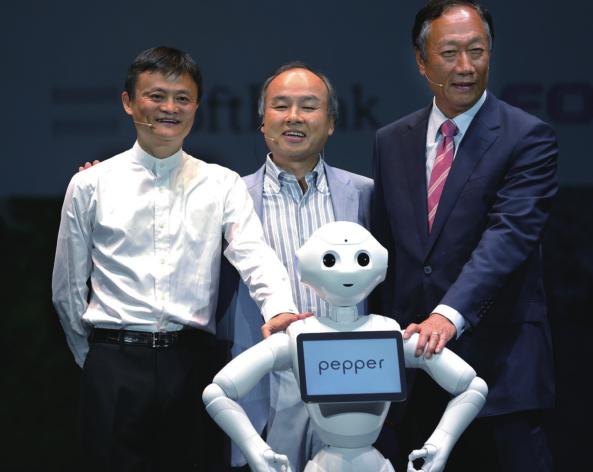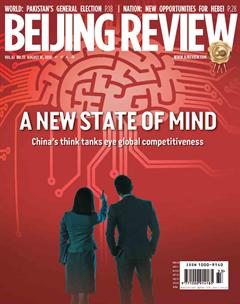Blossoming Friendship
By Li Yifan

Masashi Iwanaga, director of the Beijing office of the Japan-China Economic Association (JCEA), watched a documentary jointly produced by NHK, Japans public national broadcasting association, and China Central Television 30 years ago. It was called Silk Road, and after watching it, Iwanaga, then just a high school student, was inspired to travel to China. In pursuit of this goal, he began learning Chinese at university.
He made his fi rst trip to China by boat in 1987. “This was the beginning of my story with China,” Iwanaga told Beijing Review. His affiliation with the country has continued over the past 30 years and his current role is his third post in China. JCEA has made significant contributions to the stable development of the SinoJapanese economic and trade relationship in recent decades, and Iwanaga himself has witnessed profound changes in China as well as the ups and downs of economic and trade cooperation between the two countries.
A crucial role
As one of seven Japan-China friendship groups, JCEA was established after the normalization of bilateral diplomatic relations in 1972. Its predecessor, the Japan-China Memorandum Trade Offi ce, played a signifi -cant role in the restoration of bilateral ties. After four decades of steady development, JCEA has become a window through which bilateral economic and trade relations can be observed, and also functions as a platform for Japanese enterprises to communicate with Chinese authorities at all levels, as well as related groups and companies.
According to Iwanaga, nearly 300 large Japanese enterprises are members of the association, with its most vital work to send representatives from Japans economic circles to China.
“We send delegations to China every year even when bilateral ties are at a low level so as to ensure stable economic relations in the future,” said Iwanaga. “Last year when signs of improvement began to appear in bilateral relations, our association dispatched its largest delegation ever, sending 250 people to China. This played a part in accelerating the rapprochement of the two countries. This year, a new delegation is expected to visit China in September,” he said.
Iwanaga also expressed his expectation over Japanese Prime Minister Shinzo Abes potential visit to China. “Abe said that he would visit China this year and hopes to have people from Japans economic circles accompany him. Our association is committed to playing a crucial role alongside the government at that time.”
At a regular press conference on July 5, Chinas Foreign Affairs Ministry spokesperson Lu Kang confirmed that China had invited Abe to visit at a convenient time for both sides.
For a long time, the Sino-Japanese relationship was characterized by healthy economic exchanges but cold political interactions, which undoubtedly had a negative impact on trade. But since last year, signs that bilateral ties have been warming began to emerge. This positive trend became more obvious this year, which marks the 40th anniversary of the China-Japan Treaty of Peace and Friendship, with the resumption of the China-Japan High-Level Economic Dialogue following an eight-year hiatus and the warm reception afforded to Chinese Premier Li Keqiang during his official visit to Japan in May.
The thawing of political ties has brought new life to the economy and trade. According to Iwanaga, Lis visit to Japan generated a great deal of enthusiasm among Chinas local governments and enterprises, many of whom have dispatched their delegations to Japan in the months since. “JCEA also provided them assistance with their Japan visits, and our workload suddenly increased,” he said.
Japan has also begun to express positivity toward the Belt and Road Initiative. Abe recently praised the initiative as having the potential to link East and West, saying that he expected it to contribute to world peace and prosperity, and expressed Japans willingness to cooperate with China for this purpose.
“Under the Belt and Road Initiative, Japan and China could cooperate in the market of a third country,” Iwanaga said. “During Lis visit to Japan, the two countries signed a memorandum on third-party cooperation, which was well received by Japanese enterprises,” he noted.
Iwanaga also mentioned that the two countries could strengthen cooperation in energy and logistics by jointly establishing new energy plants with higher efficiency than those currently available. With the rapid development of freight transport between China and the European Union, Japanese enterprises hope to be able to use these trains to transport their own goods, which could increase Japans trade volume and generate profi ts for China at the same time.
Two-way investment
The latest data shows that Japanese investment in China amounted to $3.27 billion in 2017, up 5.1 percent year on year and reversing the downward trend of the prior four consecutive years. Iwanaga noted that the four-year decline was caused by the exchange rate and the structural adjustment of the Chinese economy.
“Since China adopted the reform and opening-up policy in 1978, Japanese investment in China has mainly centered on manufacturing, using Chinas inexpensive and efficient labor force for production before exporting to the world. China gained status as the worlds factory at this time,” Iwanaga said.
“But as China has become more affluent, its labor costs have increased. Chinas economic structure has also begun to change and it has become the center of global consumption rather than the worlds factory,” he noted. “As a result, Japans pre- vious investment methods are no longer appropriate and many Japanese enterprises have withdrawn from China in the past four to fi ve years. Japanese companies need time to adapt to these changes,” he said.
Statistics show that following this period of transition, many Japanese companies have begun to turn to China once again. According to a survey by the Japan External Trade Organization, 40.1 percent of Japanese enterprises in China intended to expand their investment in China in 2016, with this number increasing to 48.3 percent in 2017.
As Chinas economic strength has increased and its technological capacity improved, the shape of bilateral investment has changed with Japan becoming a destination for Chinese investment as well.
Iwanaga also suggested which areas should be the focus of Chinese investment in Japan.“Investment in tourism is welcome in Japan as it is now more eager than ever to attract tourists, to which China has contributed the most. Chinese companies know better the expectations of Chinese tourists, so by investing in Japans tourism industry, they can better provide positive experiences to Chinese visitors.”
However, Iwanaga noted that Japanese enterprises and people are cautious about foreign investment and that it is important to fi rst establish trust. “This is important and I hope Chinese companies can surmount this obstacle and increase their investment in Japan,” he added.
In the 30 years since he first became involved with China, Iwanaga has not only witnessed the twists and turns of economic and trade relations, but also experienced firsthand Chinas progress since adopting the reform and opening-up policy in 1978.
Iwanaga struck a nostalgic tone recalling China in the 1980s. “China in the 1980s left a positive impression on me. It was not abundant in material things but rich in spiritual wealth, full of expectation for its development and an energetic society. China and Japan enjoyed a good relationship then,” he said.
“After implementing the reform and opening-up policy, China saw great changes and rapid development,” he added. “The Chinese people have become better off economically. Beijings streets have become clean and beautiful, with more skyscrapers being built all the time.”

